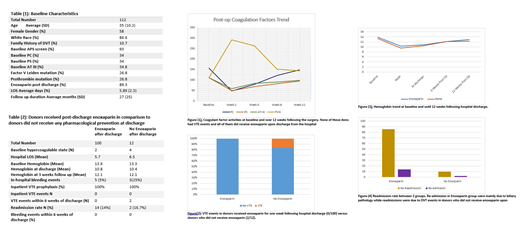Background:
Living donor liver transplant (LDLT) has expanded organ availability to patients with advanced liver failure. While this procedure decreased morbidity and mortality in recipients, it could pose a risk to the donors. Deep vein thrombosis and pulmonary embolism are known postoperative complications associated with morbidity and mortality in living liver donors. At our institution thrombophilia screening starts during donor selection process with antiphospholipid antibody panel and screening coagulation tests for all candidates. This is followed by hematology evaluation to determine the need for inherited thrombophilia screening and accordingly, hypercoagulability risk. Additionally, the institution strategy for venous thromboembolism (VTE) prevention in liver donors involves prophylactic subcutaneous heparin within 24 hours of the surgery and maintained until discharge followed by enoxaparin for 7 days after discharge. We conducted this retrospective analysis to evaluate the efficacy of these measures in reducing the rate of VTE in this population.
Methods:
Retrospective electronic medical chart review to analyze data on living liver donors in our institution between January 2000 and February 2019. Inclusion criteria: all adult living liver donors who underwent partial right hepatectomy and followed for at least 6 weeks after surgery. The primary endpoint is the rate of VTE within 6 weeks of liver donation in patients who received post-discharge enoxaparin for one week in comparison to donors who did not receive enoxaparin. Secondary endpoints: re-admission rate and bleeding events. All continuous data was presented using means, medians and standard deviation, while categorical data were presented using counts and percentages.
Results:
At our institution 112 liver donors underwent right hepatectomy. Baseline characteristics (Table-1): The average age was 34 years, 58% were females and 86% were white. 10% of donors reported family history of DVT/PE. 90% of donors were screened for antiphospholipid antibody syndrome, with one case with positive titers. 34% of donors were screened for protein C (PC), Protein S (PS) and Antithrombin deficiency (AT-III). There were no cases of PC or AT-III deficiency, but one case of mild PS deficiency was identified. 38% cases were screened for factor V Leiden and prothrombin mutations, with 3 donors carrying heterozygous factor V Leiden mutation and one with heterozygous prothrombin mutation.
All donors received prophylactic heparin during their stay in the hospital. A total of 15 donors had coagulation factors checked before and after the surgery. Post operatively, there was significant transient deficiency in PC, PS and AT-III, as well as significant increase in factor VIII level. This imbalance peaked within one week of surgery, with PC mean activity of 48%, PS mean activity of 48%, AT-III mean activity of 53% and FVIII of 290%. Factor activities started to recover by third week of surgery and returned to baseline within 8 weeks (figure 1).
A total of 100 patients received one week of prophylaxis with Enoxaparin after being discharged from the hospital (Table-2). There was no VTE incidents in this group. 14/100 were readmitted to the hospital within 6 weeks of initial hospital admission; none due to bleeding. A total of 12 patients did not receive any pharmacological preventive measures upon discharge; due to in-hospital bleeding in 3 cases, prior to starting this strategy in 4 cases, unknown reason in 5 cases. VTE events and subsequent readmissions occurred in 2/12 (16.7%) (figure 2). Odds ratio could not be performed due to the very small number of patients in the comparison group (Table-2).
Conclusion:
Partial hepatectomy for liver donation is associated with significant remote hypercoagulable state due to the sudden loss in liver volume and concomitant transient deficiency of PC, PS and AT-III as well as increasing Factor VIII activity. This thrombophilia peaks within one week after the surgery and starts to recover by the third week. Clinicians should consider performing baseline thrombophilia screening and subsequently exclude potential donors with preexisting hypercoagulable state. Extending pharmacological VTE prevention with enoxaparin for 7 days after hospital discharge has been successful in reducing the VTE risk without increasing risk of bleeding or readmission rate in our patient population.
Kuriakose:Alexion: Consultancy, Honoraria, Speakers Bureau; Bayer: Consultancy.
Author notes
Asterisk with author names denotes non-ASH members.


This feature is available to Subscribers Only
Sign In or Create an Account Close Modal